Renée Björling (1888-1975) was a Swedish film and stage actress, who peaked in the Swedish silent cinema. Later she also played small parts in Ingmar Bergman's films and also in his stage plays.
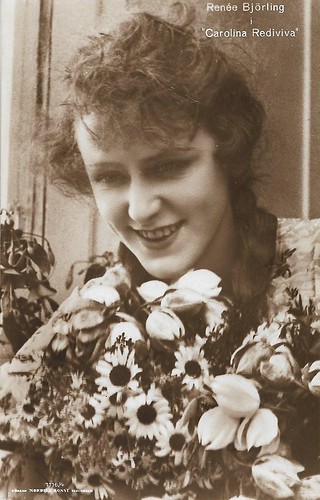
Swedish postcard by Förlag Nordisk Konst, Stockholm, no. 1116/4. Renée Björling in the Swedish silent film Carolina Rediviva (1920), directed by Ivan Hedqvist, who also played one of the leads.
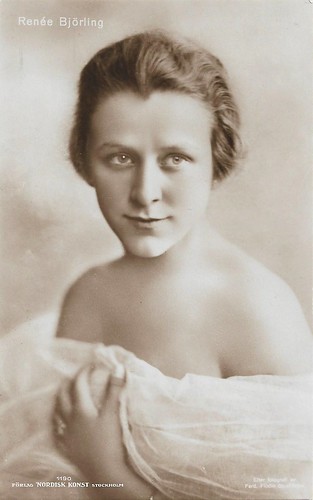
Swedish postcard by Förlag Nordisk Konst, no. 1190. Photo: Ferd. Flodin, Stockholm.

Swedish postcard by Förlag Nordisk Konst, Stockholm, no. 1275. Photo: M. Benkow, Atelier Kronen, Stockholm.
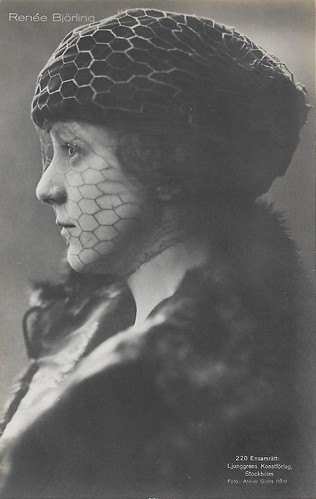
Swedish postcard by Exclusive Ljunggrens Konstförlag, Stockholm, No. 220. Photo: Atelier Gösta Hard.
Renée Louise Björling was born in 1888 in Lovö, Sweden. Her mother was actress Manda Björling (1876–1960). Her half-sister was opera singer Sigurd Björling (1907–1983).
Renée Björling debuted in 1909 on stage and studied stage acting in 1915-1917 at the Dramatens elevskola. Afterwards she acted at various theatres, e.g. the Nya Teatern, Lorensbergsteatern and the Kungliga Dramatiska Teatern (now Dramaten).
As film actress, she debuted in Fadren/Father (Anna Hofman-Uddgren, 1912), based on a play by August Strindberg. Björling played Bertha, daughter of the protagonist Adolf (August Falck). Afterwards she acted e.g. in the title role in Dunungen/The Quest for Happiness (Ivan Hedqvist, 1919) opposite Hedqvist himself, as Dortka in Victor Sjöström’s Klostret i Sendomir/The Monastery of Sendomir (1920) with Tore Svennberg and Tora Teje, and as the lead of Carol[in]a in Carolina Rediviva (Ivan Hedqvist, 1920) with, again, Hedqvist himself.
Her silent career continued to flower with films such as En vildfagel/Give Me My Son (John W. Brunius, 1920) with Tore Svennberg, Vallfarten till Kevlaar/The Pilgrimage to Kevlaar (Ivan Hedqvist, 1921) with Torsten Bergström, and Fröken Fob (Elis Ellis, 1923) with Rudolph Forster.
Later films include Norrtullsligan/The Nurtull Gang (Per Lindberg, 1923) with Tora Teje, Carl XIIs Kurir/King Karl XII's Courier (Rudolph Antoni, 1924) with Gösta Ekman and Nils Asther, Livet pa landet/Life in the Country (Ivan Hedqvist, 1924), Halta Lena och Vindögda Per/Limping Lena and Cockeyed Peter (Sigur Wallén, 1925), and Tva konungar/Two Kings (Elis Ellis, 1925).
Her last silent parts were in the farce Charlis tant/Charlie's Aunt (Elis Ellis, 1926), and Gustav Wasa del I/Gustav Wasa, Part One (John W. Brunius, 1928) with Gösta Ekman in the lead.

Swedish postcard by Nordisk Konst, Stockholm, no. 1091/1. Publicity still for the Swedish silent film Dunungen/In Quest of Happiness (Ivan Hedqvist 1919), starring Renée Björling and Ragnar Widestedt.
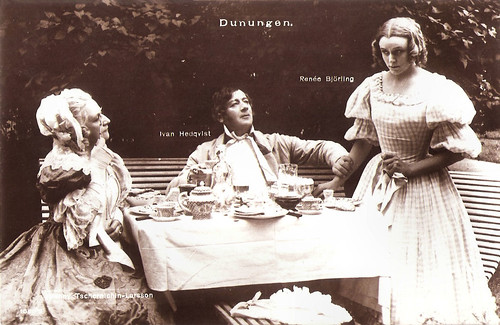
Swedish postcard by Nordisk Konst, Stockholm, no. 1091/?. Photo: publicity still for the Swedish silent film Dunungen/In Quest of Happiness (Ivan Hedqvist, 1919), based on a novel by Selma Lagerlöf. The man in the middle is director Ivan Hedqvist as Theodor and the lady on the left is Jenny Tschernichin-Larsson, who plays Teodor's mother.
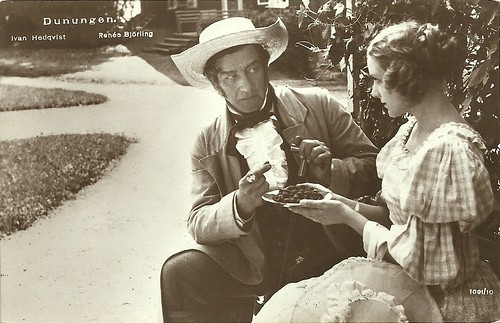
Swedish postcard by Nordisk Konst, Stockholm, no. 1091/10. Photo: publicity still for the Swedish silent film Dunungen/In Quest of Happiness (Ivan Hedqvist 1919), starring Renée Björling and Ivan Hedqvist.
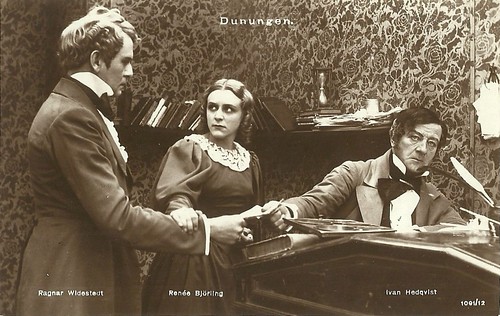
Swedish postcard by Nordisk Konst, Stockholm, no. 1091/12. Publicity still for the Swedish silent film Dunungen/In Quest of Happiness (Ivan Hedqvist 1919), starring Renée Björling, Ivan Hedqvist and Ragnar Widestedt.
In the early 1930s, Renée Björling played parts in Vi som gar köksvägen/Servant's Entrance (Gustav Molander 1932) and the sequel Vi som går kjøkkenveien/We who walk the kitchen path (Tancred Ibsen, 1933). During the war years, Björling had two leads in Gustav Molander's Striden går vidare/The Fight Continues (1941) opposite Victor Sjöström, and in Släkten är bäst/The family is best (Ragnar Falck, 1944) with Sigurd Wallén.
Björling also appeared in small parts in several films of Ingmar Bergman. She was Aunt Elisabeth in Sommarlek/Summer Interlude (Ingmar Bergman, 1961) starring Maj-Britt Nilsson, and also appeared in Sommaren med Monika/Summer with Monica (Ingmar Bergman, 1953) starring Harriet Andersson, in En lektion i kärlek/A Lesson in Love (Ingmar Bergman, 1954) with Eva Dahlbeck, and in Kvinnodröm/Dreams (Ingmar Bergman, 1955). Bergman also directed Björling four times at the Dramaten, e.g. in 1964 in Ibsen's Hedda Gabler.
Among her later films were Sceningang/Stage Door (Bengt Ekerot, 1958), written by Erland Josephson, and Kvinnen i leopard/The Woman with the Fur Coat (Jan Molander, 1958), starring Harriet Andersson. She also acted twice on television, in the 1955 American TV series Foreign Intrigue, and as Mrs. Higgins in Pygmalion in 1968, starring Gunnar Björnstrand (Henry Higgins) and Harriet Andersson (Eliza Doolittle). On stage she had already played Mrs. Higgins at the Dramaten in 1952, opposite Lars Hanson and Anita Björk.
At the Dramaten, she acted in some 130 stage plays. Her partners included Gunnar Björnstrand (e.g. Molière's L'Avare in 1935), Lars Hanson (e.g. William Shakespeare's Romeo and Juliet in 1936), Anita Björk (e.g. L'Invitation au Château by Jean Anouilh in 1951), Jarl Kulle (e.g. in Aeschylus' Oresteia in 1954), or Gunn Wållgren (e.g. in Ivanov by Anton Chekhov in 1957).
Björling worked several times with Alf Sjöberg at Dramaten. First as an actor (e.g. in Madame Sans-Gêne by Victorien Sardou and Émile Moreau in 1927), and then as a director (e.g. in Les Mouches by Jean-Paul Sartre in 1945, with Stig Järrel and Mai Zetterling), as well as Mimi Pollak, also as an actress (e.g. in The Cherry Orchard by Anton Chekhov in 1946) and as director (e.g. in A Flea in Her Air by Georges Feydeau in 1968).
Renée Björling stopped her film and TV career in 1968. She had played in some 40 silent and sound films. On stage, she performed for the last time at the Dramaten in 1971, in Euripides' Les Troyennes (in an adaptation by Jean-Paul Sartre), with Gunnel Lindblom and Mona Malm.
Renée Björling died in 1975 in Täby. She lies buried at Skogskyrkogården cemetery in Stockholm. From 1925 to 1932 she had been married to captain Gunnar Ursell and had a daughter Monica with him. Her granddaughter is opera singer Malena Ernman.

Swedish postcard by Förlag Nordisk Konst, Stockholm, no. 1092/3. Photo: publicity still for Klostret i Sendomir/The Monastery of Sendomir (Victor Sjöström, 1920) with Renée Björling and Tora Teje.
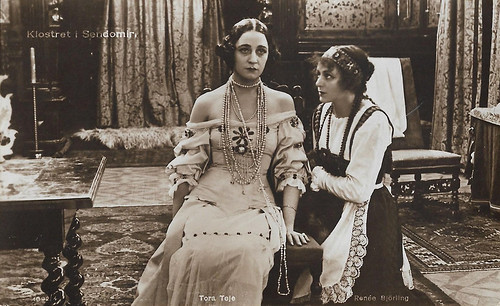
Swedish postcard by Förlag Nordisk Konst, Stockholm, no. 1092/4. Photo: publicity still for Klostret i Sendomir/The Monastery of Sendomir (Victor Sjöström, 1920) with Tora Teje and Renée Björling.
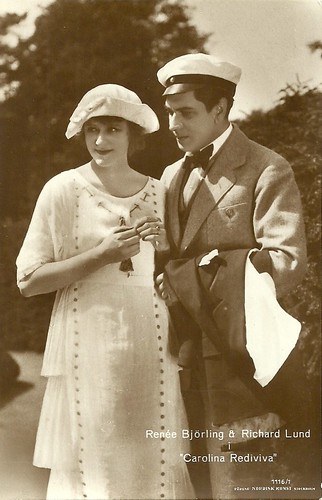
Swedish postcard by Nordisk Konst, Stockholm, no. 1116/1. Renée Björling and Richard Lund in Carolina Rediviva (Ivan Hedqvist, 1920).
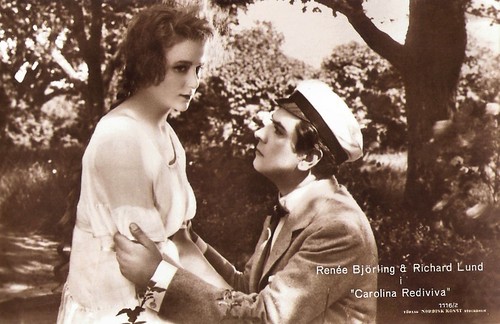
Swedish postcard by Nordisk Konst, Stockholm, no. 1116/2. Photo: publicity still for Carolina Rediviva (Ivan Hedqvist, 1920) with Richard Lund.

Swedish postcard by Axel Eliassons Konstförlag, no.288, Stockholm. Photo: Skandia-Film / Svensk Filmindustri. Publicity still for the drama En vildfågel/My adopted son (John W. Brunius, 1921) with Pauline Brunius, Tore Svennberg, Renée Björling and Paul Seelig.
Sources: Svensk Filmdatabas (Swedish), Wikipedia (Swedish, English and German) and IMDb.

Swedish postcard by Förlag Nordisk Konst, Stockholm, no. 1116/4. Renée Björling in the Swedish silent film Carolina Rediviva (1920), directed by Ivan Hedqvist, who also played one of the leads.

Swedish postcard by Förlag Nordisk Konst, no. 1190. Photo: Ferd. Flodin, Stockholm.

Swedish postcard by Förlag Nordisk Konst, Stockholm, no. 1275. Photo: M. Benkow, Atelier Kronen, Stockholm.

Swedish postcard by Exclusive Ljunggrens Konstförlag, Stockholm, No. 220. Photo: Atelier Gösta Hard.
The Quest for Happiness
Renée Louise Björling was born in 1888 in Lovö, Sweden. Her mother was actress Manda Björling (1876–1960). Her half-sister was opera singer Sigurd Björling (1907–1983).
Renée Björling debuted in 1909 on stage and studied stage acting in 1915-1917 at the Dramatens elevskola. Afterwards she acted at various theatres, e.g. the Nya Teatern, Lorensbergsteatern and the Kungliga Dramatiska Teatern (now Dramaten).
As film actress, she debuted in Fadren/Father (Anna Hofman-Uddgren, 1912), based on a play by August Strindberg. Björling played Bertha, daughter of the protagonist Adolf (August Falck). Afterwards she acted e.g. in the title role in Dunungen/The Quest for Happiness (Ivan Hedqvist, 1919) opposite Hedqvist himself, as Dortka in Victor Sjöström’s Klostret i Sendomir/The Monastery of Sendomir (1920) with Tore Svennberg and Tora Teje, and as the lead of Carol[in]a in Carolina Rediviva (Ivan Hedqvist, 1920) with, again, Hedqvist himself.
Her silent career continued to flower with films such as En vildfagel/Give Me My Son (John W. Brunius, 1920) with Tore Svennberg, Vallfarten till Kevlaar/The Pilgrimage to Kevlaar (Ivan Hedqvist, 1921) with Torsten Bergström, and Fröken Fob (Elis Ellis, 1923) with Rudolph Forster.
Later films include Norrtullsligan/The Nurtull Gang (Per Lindberg, 1923) with Tora Teje, Carl XIIs Kurir/King Karl XII's Courier (Rudolph Antoni, 1924) with Gösta Ekman and Nils Asther, Livet pa landet/Life in the Country (Ivan Hedqvist, 1924), Halta Lena och Vindögda Per/Limping Lena and Cockeyed Peter (Sigur Wallén, 1925), and Tva konungar/Two Kings (Elis Ellis, 1925).
Her last silent parts were in the farce Charlis tant/Charlie's Aunt (Elis Ellis, 1926), and Gustav Wasa del I/Gustav Wasa, Part One (John W. Brunius, 1928) with Gösta Ekman in the lead.

Swedish postcard by Nordisk Konst, Stockholm, no. 1091/1. Publicity still for the Swedish silent film Dunungen/In Quest of Happiness (Ivan Hedqvist 1919), starring Renée Björling and Ragnar Widestedt.

Swedish postcard by Nordisk Konst, Stockholm, no. 1091/?. Photo: publicity still for the Swedish silent film Dunungen/In Quest of Happiness (Ivan Hedqvist, 1919), based on a novel by Selma Lagerlöf. The man in the middle is director Ivan Hedqvist as Theodor and the lady on the left is Jenny Tschernichin-Larsson, who plays Teodor's mother.

Swedish postcard by Nordisk Konst, Stockholm, no. 1091/10. Photo: publicity still for the Swedish silent film Dunungen/In Quest of Happiness (Ivan Hedqvist 1919), starring Renée Björling and Ivan Hedqvist.

Swedish postcard by Nordisk Konst, Stockholm, no. 1091/12. Publicity still for the Swedish silent film Dunungen/In Quest of Happiness (Ivan Hedqvist 1919), starring Renée Björling, Ivan Hedqvist and Ragnar Widestedt.
Ingmar Bergman
In the early 1930s, Renée Björling played parts in Vi som gar köksvägen/Servant's Entrance (Gustav Molander 1932) and the sequel Vi som går kjøkkenveien/We who walk the kitchen path (Tancred Ibsen, 1933). During the war years, Björling had two leads in Gustav Molander's Striden går vidare/The Fight Continues (1941) opposite Victor Sjöström, and in Släkten är bäst/The family is best (Ragnar Falck, 1944) with Sigurd Wallén.
Björling also appeared in small parts in several films of Ingmar Bergman. She was Aunt Elisabeth in Sommarlek/Summer Interlude (Ingmar Bergman, 1961) starring Maj-Britt Nilsson, and also appeared in Sommaren med Monika/Summer with Monica (Ingmar Bergman, 1953) starring Harriet Andersson, in En lektion i kärlek/A Lesson in Love (Ingmar Bergman, 1954) with Eva Dahlbeck, and in Kvinnodröm/Dreams (Ingmar Bergman, 1955). Bergman also directed Björling four times at the Dramaten, e.g. in 1964 in Ibsen's Hedda Gabler.
Among her later films were Sceningang/Stage Door (Bengt Ekerot, 1958), written by Erland Josephson, and Kvinnen i leopard/The Woman with the Fur Coat (Jan Molander, 1958), starring Harriet Andersson. She also acted twice on television, in the 1955 American TV series Foreign Intrigue, and as Mrs. Higgins in Pygmalion in 1968, starring Gunnar Björnstrand (Henry Higgins) and Harriet Andersson (Eliza Doolittle). On stage she had already played Mrs. Higgins at the Dramaten in 1952, opposite Lars Hanson and Anita Björk.
At the Dramaten, she acted in some 130 stage plays. Her partners included Gunnar Björnstrand (e.g. Molière's L'Avare in 1935), Lars Hanson (e.g. William Shakespeare's Romeo and Juliet in 1936), Anita Björk (e.g. L'Invitation au Château by Jean Anouilh in 1951), Jarl Kulle (e.g. in Aeschylus' Oresteia in 1954), or Gunn Wållgren (e.g. in Ivanov by Anton Chekhov in 1957).
Björling worked several times with Alf Sjöberg at Dramaten. First as an actor (e.g. in Madame Sans-Gêne by Victorien Sardou and Émile Moreau in 1927), and then as a director (e.g. in Les Mouches by Jean-Paul Sartre in 1945, with Stig Järrel and Mai Zetterling), as well as Mimi Pollak, also as an actress (e.g. in The Cherry Orchard by Anton Chekhov in 1946) and as director (e.g. in A Flea in Her Air by Georges Feydeau in 1968).
Renée Björling stopped her film and TV career in 1968. She had played in some 40 silent and sound films. On stage, she performed for the last time at the Dramaten in 1971, in Euripides' Les Troyennes (in an adaptation by Jean-Paul Sartre), with Gunnel Lindblom and Mona Malm.
Renée Björling died in 1975 in Täby. She lies buried at Skogskyrkogården cemetery in Stockholm. From 1925 to 1932 she had been married to captain Gunnar Ursell and had a daughter Monica with him. Her granddaughter is opera singer Malena Ernman.

Swedish postcard by Förlag Nordisk Konst, Stockholm, no. 1092/3. Photo: publicity still for Klostret i Sendomir/The Monastery of Sendomir (Victor Sjöström, 1920) with Renée Björling and Tora Teje.

Swedish postcard by Förlag Nordisk Konst, Stockholm, no. 1092/4. Photo: publicity still for Klostret i Sendomir/The Monastery of Sendomir (Victor Sjöström, 1920) with Tora Teje and Renée Björling.

Swedish postcard by Nordisk Konst, Stockholm, no. 1116/1. Renée Björling and Richard Lund in Carolina Rediviva (Ivan Hedqvist, 1920).

Swedish postcard by Nordisk Konst, Stockholm, no. 1116/2. Photo: publicity still for Carolina Rediviva (Ivan Hedqvist, 1920) with Richard Lund.

Swedish postcard by Axel Eliassons Konstförlag, no.288, Stockholm. Photo: Skandia-Film / Svensk Filmindustri. Publicity still for the drama En vildfågel/My adopted son (John W. Brunius, 1921) with Pauline Brunius, Tore Svennberg, Renée Björling and Paul Seelig.
Sources: Svensk Filmdatabas (Swedish), Wikipedia (Swedish, English and German) and IMDb.
No comments:
Post a Comment